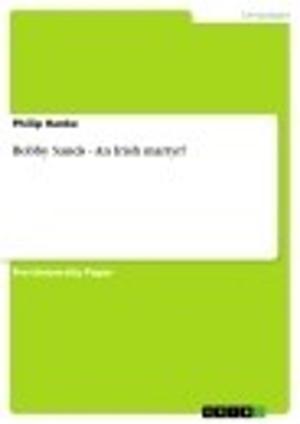Reality and Illusion in Tennessee Williams' 'A Streetcar Named Desire'
An Analysis of Frequent Symbols
Fiction & Literature, Literary Theory & Criticism, British| Author: | Ilona Sontag | ISBN: | 9783640559558 |
| Publisher: | GRIN Publishing | Publication: | March 9, 2010 |
| Imprint: | GRIN Publishing | Language: | English |
| Author: | Ilona Sontag |
| ISBN: | 9783640559558 |
| Publisher: | GRIN Publishing |
| Publication: | March 9, 2010 |
| Imprint: | GRIN Publishing |
| Language: | English |
Seminar paper from the year 2009 in the subject English - Literature, Works, grade: 1,7, RWTH Aachen University (Institut für Anglistik I), course: Hauptseminar 'American Drama', language: English, abstract: Tennessee Williams, born Thomas Lanier Williams, is not only known for being a 'talented, perceptive and influential American playwright' (Day 1987, vii), but also for his frequent use of symbols. 'A Streetcar Named Desire' (1947), the work which will be dealt with in this paper, is a good example for of usage, since it contains a lot of different kinds of symbolism, for example concerning colours, names, music and many more. Numerous works will be found, if anyone searches for essays about symbolism in Williams' works. Moreover, it is common knowledge that Streetcar is a play which deals not only superficially with a woman going insane, but a play which 'bring[s] into violent contrast a neurotic woman's dream world and the animalistic realism of her brother-in-law' (back of the book in the Diesterweg edition). But since there does not seem to be any work which deals with the question of how exactly Williams drew this contrast by use of symbolism, it will be my aim in this paper to analyse this question. Consequently, I will try to point out the main symbols with which Williams underlined the contrast between realism and illusion, especially considering names, colours, clothes, light, music and certain rituals of the main characters. In the second part of this paper, I will deal with the question to what degree the main characters Stanley and Blanche are strictly opposed to each other or may have something in common. I will also deal with the meaning of the ending concerning realism and illusion. Therefore, what will be discussed are the most striking antinomies and similes in the main characters' attitudes. A general conclusion about the topic of symbolism in Tennessee Williams' Streetcar will be given in the end. To introduce the reader to the topic and also to justify my choice of symbols, a definition of the notion of symbolism will be given right at the beginning of this paper. This will be done by including different approaches, so that a broader definition can be given. Furthermore, for this paper is based on symbolism in Streetcar by Tennessee Williams, it may also be very interesting for the reader to have a look at Williams' attitude towards symbols which will be done at the end of the second chapter. One last point to mention in this introduction is that due to space restrictions not all symbols concerning the topic of illusion and realism can be discussed in this paper. Nevertheless, it is my aim to present the most striking ones.
Seminar paper from the year 2009 in the subject English - Literature, Works, grade: 1,7, RWTH Aachen University (Institut für Anglistik I), course: Hauptseminar 'American Drama', language: English, abstract: Tennessee Williams, born Thomas Lanier Williams, is not only known for being a 'talented, perceptive and influential American playwright' (Day 1987, vii), but also for his frequent use of symbols. 'A Streetcar Named Desire' (1947), the work which will be dealt with in this paper, is a good example for of usage, since it contains a lot of different kinds of symbolism, for example concerning colours, names, music and many more. Numerous works will be found, if anyone searches for essays about symbolism in Williams' works. Moreover, it is common knowledge that Streetcar is a play which deals not only superficially with a woman going insane, but a play which 'bring[s] into violent contrast a neurotic woman's dream world and the animalistic realism of her brother-in-law' (back of the book in the Diesterweg edition). But since there does not seem to be any work which deals with the question of how exactly Williams drew this contrast by use of symbolism, it will be my aim in this paper to analyse this question. Consequently, I will try to point out the main symbols with which Williams underlined the contrast between realism and illusion, especially considering names, colours, clothes, light, music and certain rituals of the main characters. In the second part of this paper, I will deal with the question to what degree the main characters Stanley and Blanche are strictly opposed to each other or may have something in common. I will also deal with the meaning of the ending concerning realism and illusion. Therefore, what will be discussed are the most striking antinomies and similes in the main characters' attitudes. A general conclusion about the topic of symbolism in Tennessee Williams' Streetcar will be given in the end. To introduce the reader to the topic and also to justify my choice of symbols, a definition of the notion of symbolism will be given right at the beginning of this paper. This will be done by including different approaches, so that a broader definition can be given. Furthermore, for this paper is based on symbolism in Streetcar by Tennessee Williams, it may also be very interesting for the reader to have a look at Williams' attitude towards symbols which will be done at the end of the second chapter. One last point to mention in this introduction is that due to space restrictions not all symbols concerning the topic of illusion and realism can be discussed in this paper. Nevertheless, it is my aim to present the most striking ones.















